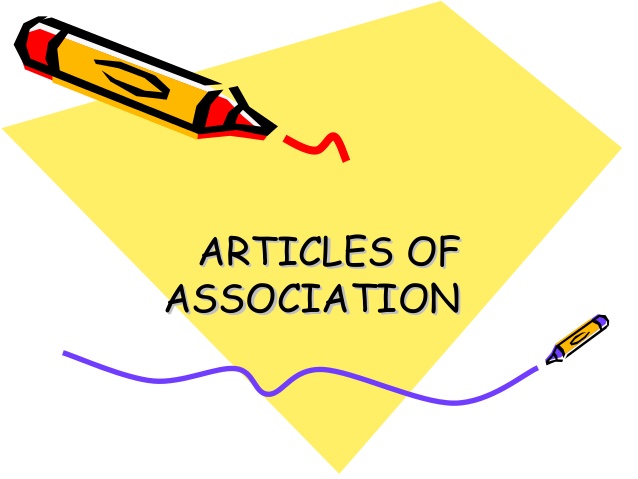In this blogpost, Vyoma Mehta, Student, NMIMS, School of Law, and the Diploma in Entrepreneurship Administration and Business Laws by NUJS, writes about the content of article of association and entrenchment.
Introduction
Articles of Association is a document which prescribes the rules and bye-laws for the general management of the company and for the attainment of its object as given in the memorandum of association of the company.[1] It is a document of paramount significance in the life of a company as it contains the regulations for the internal administration of the company’s affairs.
The articles of association are a subsidiary to the memorandum of association of the company. They define the rights, duties, powers of the management of a company as between themselves and the company at large. Further, they also prescribe the mode and form in which changes in the internal regulation of a company may be made from time to time. The articles of association of a company must always be in consonance with the memorandum of that company and being subordinate to the memorandum; they cannot extend the objects of a company as specified in the memorandum of the company.[2]
In the case of Naresh Chandra Sanyal v. Calcutta Stock Exchange Association Ltd[3], the Supreme Court provided that the articles of association of a company also establish a contract between the company and its members as well as between the members. This contract governs the ordinary rights and obligations incidental to the membership in the company.
Articles of association are like the partnership deed in a partnership. They particularly provide for matters such as the making of calls, forfeiture of shares, directors qualifications, the procedure for transfer and transmission of shares and debentures, powers, duties and appointment of auditors.
The following companies must have their own articles of association:
- Unlimited Companies
- Companies limited by guarantee
- Private companies limited by shares
Contents of Articles of Association
Section 5(1) and section 5(2) of the Companies Act, 2013 provide for the contents of the articles of association.[4] The articles must contain the regulations for the management of the company along with the matters prescribed by the Central Government. Further, the articles of association must also contain the following:
- Share capital including sub-division, rights of various shareholders, the relationship of these rights, payment of commission, share certificates.
- Lien of shares: Lien of shares means to retain possession of shares incase the member is unable to pay his debt to the company.
- Calls on shares: Calls on shares include the whole or part remaining unpaid on each share which has to be paid by the shareholders on the company’s demand.
- Transfer of shares: The articles of association include the procedure for the transfer of shares by the shareholder to the transferee.
- Transmission of shares: Transmission includes devolution of title by death, succession, marriage, insolvency, etc. It is not voluntary but is in fact brought about by operation of law.
- Forfeiture of shares: The articles of association provide for the forfeiture of shares if the purchase requirements such as paying any allotment or call money, are not met with.
- Surrender of shares: Surrender of shares is when the shareholders voluntary return the shares they own to the company.
- Conversion of shares in stock: In consonance with the articles of association, the company can convert the shares into stock by an ordinary resolution in a general meeting.
- Share warrant: A share warrant is a bearer document relating to the title of shares and cannot be issued by private companies; only public limited companies can issue a share warrant.
- Alteration of capital: Increase, decrease or rearrangement of capital must be done as the articles of association provide.
- General meetings and proceedings: All the provisions relating to the general meetings and the manner in which they are to be conducted are to be contained in the articles of association.
- Voting rights of members, voting by poll, proxies: The members right to vote on certain company matters and the manner in which voting can be done is provided in the articles of association.
- Directors, their appointment, remuneration, qualifications, powers and proceedings of the boards of directors meetings.
- Dividends and reserves: The articles of association of a company also provide for the distribution of dividend to the shareholders.
- Accounts and Audits: The auditing of a company shall be done subject to the provisions of the articles of association of the company.
- Borrowing powers: Every company has powers to However, this must be done according to the articles of association of the company.
- Winding up: Provisions relating to the winding up of the company finds mention in articles of association of the company and must be done accordingly.
Entrenchment
The articles of association may contain entrenchment provisions. However, this concept of entrenchment was not present in the Companies Act, 1956. The word entrench means to establish an attitude, habit, or belief so firmly that change is very difficult or unlikely.[5] Thus, an entrenchment clause is the one which makes certain amendments either impossible or difficult.
The company has the discretion to include entrenchment provisions in its articles of association.[6] Such provision may relate to the effect that specified provisions of the articles may be altered only if conditions or procedures as that are more restrictive than those applicable in the case of a special resolution, are met or complied with. An entrenchment provision can be made at the time of incorporation of the company[7], or after the incorporation of the company by way of an amendment to the articles of association of the company.[8]
The format for the articles of association of a company must be in the manner prescribed by the form provided in Schedule I of the Companies Act, 2013.
Usually, the articles of association of a public limited company are prepared by taking good professional advice and are very carefully prepared from the beginning. It is only the private limited companies which have to keep a check on the following while drafting the articles of association:
- The Companies Act, 2013 provides for the model articles for a company under section 5[9]. Thus, it is to be remembered that even though there is the use of the words such as ‘preparation of articles’ while getting a company incorporated, it only means an adoption of the model articles as provided by the act with a few modifications as the promoters may insist.
- As much as possible, the promoters must refrain from any additions, changes, alterations or deletions in the model articles provided by the act. This is mainly because, Schedule I of the Companies Act, 2013, from table – to the table – , provides for the forms for articles of different type of companies. Thus, more or less the model articles contain the required contents for a particular company. Additions or alterations must only be done if it is necessary to have a new regulation in the articles of association, or if a new regulation is a must for promoting the company.
- The additions, changes or alterations which are made to the model articles, must be done with careful scrutiny of the provisions of the Companies Act, 2013.
Conclusion
It is a settled company law principle that the articles of association of a company cannot override the provisions of the Companies Act, 2013. Further, the articles of association of a particular company are also bound to observe the memorandum of association of the company as the articles are subordinate to the charter which is the memorandum of the company as well as any other company law in force at that time. Thus, it is of primary importance that when a company is being incorporated, and the articles of association of the company are being prepared, the same must be done in consonance with memorandum of association, the Companies Act, 2013 and any other company law which is in force at that time.
If you want to learn more about COMPANIES ACT, 2013 you can take up this course that is created by iPleaders in association with National University of Juridical Sciences (NUJS), Kolkata which is regularly ranked as one of India’s top three law schools
LawSikho has created a telegram group for exchanging legal knowledge, referrals and various opportunities. You can click on this link and join:
https://t.me/joinchat/J_
[1] http://www.legalservicesindia.com/article/article/articles-of-association-&-alteration-of-articles-1050-1.html (January 25, 2016).
[2] Ashbury Railway Carriage Co. vs. Riche (1875) LR 7 HL 653
[3] AIR 1971 SC 422
[4] Section 5, Companies Act, 2013:
(1) The articles of a company shall contain the regulations for management of the company.
(2) The articles shall also contain such matters, as may be prescribed: Provided that nothing prescribed in this sub-section shall be deemed to prevent a company from including such additional matters in its articles as may be considered necessary for its management.
[5] http://www.oxforddictionaries.com/definition/english/entrench, (January 25, 2016)
[6] Section 5(3), Companies Act, 2013,
[7] Section 5(4), Companies Act, 2013.
[8] Section 5(5), Companies Act, 2013.
[9] Section 5(7), Co.mpanies Act, 2013.













Thanx for this answer??
Best language for anyone to understand in a simple way… Thanx ipleaders and Miss Vyoma Mehta??